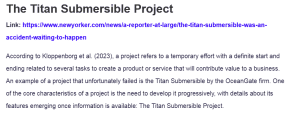The Titan Submersible Project
According to Kloppenborg et al. (2023), a project refers to a temporary effort with a definite start and ending related to several tasks to create a product or service that will contribute value to a business. An example of a project that unfortunately failed is the Titan Submersible by the OceanGate firm. One of the core characteristics of a project is the need to develop it progressively, with details about its features emerging once information is available: The Titan Submersible Project.
The dream of the OceanGate firm to build a submersible was conceptualized in 2015 when the company built Cyclops I, designed not to go deeper than 500 meters (Taub, 2023). This shows the Titan Submersible is a project that has been refined over time. Another core characteristic of a project is the participation of unique stakeholders who are impacted by the outcome, and this is true for OceanGate’s pursuit since the mission was funded by private individuals who wanted to explore.
A major failure in the Titanic submersible project was the dismissal of warnings about the submersible’s design flaws. Warnings about the submersible’s design flaws were issued to OceanGate and the US government five years earlier, before June 2023 (Taub, 2023). Although experts made the necessary attempts to push Rush, OceanGate’s CEO, to abandon the project, he ignored the design flaws and went ahead with the project.
Before committing to the project, Rush and OceanGate’s marine experts should have assessed the organization’s ability to perform the project. By analyzing internal skills, capabilities, technical knowledge, and resource availability, a company will decide if it has what it takes to complete a project (Kloppenborg et al., 2023). OceanGate failed to undertake this crucial assessment and consider advice from industry experts, with specific reference to military organizations that have successfully built submersibles in the past. It is most likely that the company was committed to the dream of being the pioneer in advanced submersible construction, throwing caution into the wind in the process.
References
Kloppenborg, T. J., Anantatmula, V., & Wells, K. N. (2023). Contemporary project management: Plan driven and agile approaches. Cengage Learning
Taub, B. (2023, July 1). The Titan submersible was “An accident waiting to happen.” The New Yorker. https://www.newyorker.com/news/a-reporter-at-large/the-titan-submersible-was-an-accident-waiting-to-happen
ORDER A PLAGIARISM-FREE PAPER HERE
We’ll write everything from scratch
Question 
Identify a recent news article/event involving a project that would be deemed a failure (in terms of what we define as a project failure). Include a hyperlink to the news article/video in your response.
Action: Identify a 2023 article/ video involving a project that failed. Then respond to the following questions:
- What was the project and why is it considered a project? (Include how it fits the formal definition of a project).
- What went wrong with the project that you would define it a failure?
- What could have been done differently that would have prevented the project from failing?

The Titan Submersible Project
In the past, students have included congressional bills, highway construction projects, the rollout of a new product (e.g. Tesla), etc. Don’t overthink it, just ensure conceptually it fits the definition of a project, and ensure you include that definition as well as why it failed (in project terms).
- Please read and follow the instructions strictly. please this assignment is submitted to Turnitin software, no AI work.
- This is the class textbook Text: Contemporary Project Management: Plan-Driven and Agile Approaches, 5E by Timothy Kloppenborg; Vittal S. Anantatmula; Kathryn Wells [ISBN: 9780357715734].
